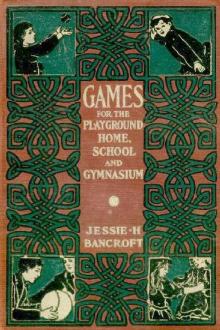Games for the Playground, Home, School and Gymnasium by Jessie Hubbell Bancroft (top novels of all time .txt) 📕

- Author: Jessie Hubbell Bancroft
- Performer: -
Book online «Games for the Playground, Home, School and Gymnasium by Jessie Hubbell Bancroft (top novels of all time .txt) 📕». Author Jessie Hubbell Bancroft
4 to 10 players.
Out of doors; seashore.
This game may be played with pebbles, shells, or nuts, each player having two or four of such articles. The object of the game is to throw these pebbles into a hole about four inches in diameter, which should be made in the ground. The first part of the game is concerned with determining the order in which the players shall take turns. Ten feet from the hole a place is marked, from which the players throw in turn until each has had enough turns to have thrown all of his pebbles. The one who has succeeded in landing a pebble nearest the hole becomes the first player, and takes his stand on a second mark drawn one fourth nearer the hole, all the players meanwhile having gathered up their pebbles again. These are all given to the successful player, and he pitches them in a mass toward the hole, becoming the owner of as many as fall into the hole. Any pebbles that do not go in the hole are gathered up by the player who in the original throwing came out second in trying to get near the hole, and he, in turn, throws these in mass, standing also at the nearer throwing point from which his predecessor threw. All of the players take turns in this way until all of the pebbles have been appropriated. The player wins who gets the most pebbles. Pebbles won are not thrown again, but kept for score.
For good players the distances from the hole may be increased.
POISON10 to 30 or more players.
Gymnasium; playground; seashore.
A circle is marked on the floor or ground considerably smaller than an outer circle formed by the players, clasping hands. Each player tries, by pulling or pushing, to induce the others to step within the smaller circle, but endeavors to keep out of it himself. Any one who touches the ground within the inner circle, if only with one foot, is said to be poisoned. As soon as this happens, the player or players so poisoned become catchers; the other players shout "Poisoned!" and at once break the circle and run for safety, which consists in standing on wood. The merest chip will answer, and growing things are not counted wood. If played in a gymnasium, iron may give immunity instead of wood. Any one caught before reaching safety, or in changing places afterward, joins the catchers, and when all have been caught, the ring is once more surrounded.
POISON SNAKE10 to 30 or more players.
Gymnasium; playground.
The players join hands to form a circle. About fifteen Indian clubs or tenpins are placed in the center of the circle, with spaces between them in which a player might step. The players then try, by pushing or pulling their comrades by means of the clasped hands, to make them knock over the clubs. Any player who overturns a club or who unclasps hands must at once leave the circle, the club being replaced. The first players so leaving start a "scrub" circle; players disqualified in the scrub circle start another in their turn, etc. The player wins who is left in the original circle. Where several circles have been formed, the several winners may form a circle at the close and play to determine the final winner.
This game has possibilities for much sport and skill. The agility with which players leap over or pass between the clubs is as important a part of the game as the pulling and pushing. The clubs should be sufficiently scattered to make it possible for a player to save himself in this way. Children may need to have this feature of the game pointed out to them. The game is equally interesting to children or adults, but obviously requires gymnasium suits for girls or women.
POM POM PULLAWAY5 to 30 or more players.
Out of doors.
This game is often played between the curbings of a city street, but is suitable for any open play space which admits of two lines drawn across it with a space of from thirty to fifty feet between them. All players stand on one side behind one of the dividing lines, except one player who is It and who stands in the center of the open ground. He calls any player by name and adds a formula, as below:—
Come away, or I'll fetch you away!"
Whereupon the player named must run across the open space to the safety line on the opposite side, the one who is It trying meanwhile to catch him before he reaches that line. If he gets over safely, he remains there until all of his comrades have joined him or have been caught. Any one caught by the one who is It joins the latter in helping to catch other players as they dash across the open space, but the one originally It remains the caller throughout the game. After all of the uncaught players have crossed to one side, they try in the same way to return to their first goal. The first one to be caught is It for the next game.
Players should give the chaser as much difficulty as possible in catching them by making feints in one direction and suddenly running in another, or by running diagonally instead of straight across, etc.
POOR PUSSY5 to 20 players.
Parlor.
The players sit in a circle, except one who is chosen for Poor Pussy. Pussy kneels in front of any player and miaous. This person must stroke or pat Pussy's head and say, "Poor Pussy! Poor Pussy! Poor Pussy!" repeating the words three times, all without smiling. If the player who is petting Puss smiles, he must change places with Puss. The Puss may resort to any variations in the music of the miaou, or in attitude or expression, to induce the one who is petting to smile.
This may be made one of the most amusing games for adults at a house party. The writer has seen some of the most dignified professional people laughing until the tears came while playing this simple little game.
POTATO RACESFour forms of Potato Race are here given as follows:—
Potato Race I. Individual competition; rules of Amateur Athletic Union of the United States. Placing potatoes on marked spots; gathering them up not a part of the game.
Potato Race II. Team competition. One player places the potatoes on spots; the next gathers them up, etc.
Potato Shuttle Relay. Rules of Girls' Branch, Public Schools Athletic League, New York City. Alternate placing and gathering up.
Potato Spoon Race. Only gathering up of potatoes.
POTATO RACE—I2 to 60 or more players.
Playground; gymnasium.
The simpler and usual Potato Race is played in two forms: (I), the players competing as individuals; and (II), competing as teams. The following description is for individual competition; the team game is described as Potato Race II. There are other forms of playing the individual game; the one given here is according to the rules of the Amateur Athletic Union.
The competitors should each wear a large number pinned across the shoulders on the back, where it may be read plainly by the judges. The competition is carried on in heats, as many players as the playing space will allow playing in each heat. Potatoes should be used, or blocks of wood are officially permissible. These wooden blocks may be secured of potato shape, and are better than those of cubical form, as the latter are apt to land on the corners and bound.
A starting line is drawn across the ground. At right angles to it a row of potatoes is placed for each player in the heat. The potatoes should be two yards apart and eight in number. (This is the official number and distance for the Amateur Athletic Union; the number varies in unofficial games, but should be equal for the different rows.) The first potato should be two yards from the receptacle, which is usually placed on the starting line, one beside each competitor. This receptacle should be a pail, basket, box, or can. The official dimensions of the A. A. U. call for its being not over two feet in height, with an opening not over thirty-six inches in circumference. In handicap events the starting mark is paid from the rear of the can. The potatoes are replaced on the marks before the beginning of each heat, the game in this form consisting solely of gathering them up, not in placing them. There is no rule against tossing a potato into the receptacle, but it is poor policy to do so, as it increases the risks of failure.
The contestants start, as for a race, in response to the starter's signals, "On your marks!" "Get set!" "Go!" The game consists in picking up the potatoes one at a time and placing them in the receptacle. The potatoes may be picked up in any order desired. A potato dropped, however, must be picked up before another potato be touched, or the player is disqualified. Similarly, a potato missing the receptacle or bounding out of it must be placed in it before the next potato be touched, or the player is disqualified. When all the potatoes have been placed in the receptacle, the player finishes by dashing across a finish line, a tape, or strand of worsted, stretched five feet back of the receptacle. As in all races in athletic form, a player is disqualified for interfering with any other competitor, or for touching the finish tape with the hands or arms: the tape should be breasted. The winners in each heat play a final race; or, with large numbers competing, semi-finals before the finals. Where small numbers are competing, those finishing first, second, and even third, may be entered for the final trials. In case of a tie, both competitors are entered for the next (final, or semi-final) heat, or, if tied in the final heat, the tied competitors play again.
POTATO RACE—II10 to 100 players.
Playground; gymnasium; seashore.
The first description here given is for an informal game. This is followed by the rules for strict athletic procedure.
The ground is marked off with a starting line. At right angles to it are marked two or more rows of spots according to the number of teams competing, the spots being from three to six feet apart, each row containing from six to ten. On each spot is placed a potato; or a stone, block of wood, or any other object may be substituted; on the seashore bathing slippers may be used. Potato-shaped blocks of wood may be had as substitutes for potatoes, and are better than cubical blocks, which are apt to land on the corners and bound.
The players are divided evenly into competing groups which line up in single file behind the starting line, each file being in line with one of the rows of potatoes. Beside the leader of each file is a box or basket; or a circle may be drawn on the ground instead. At a signal each leader





Comments (0)